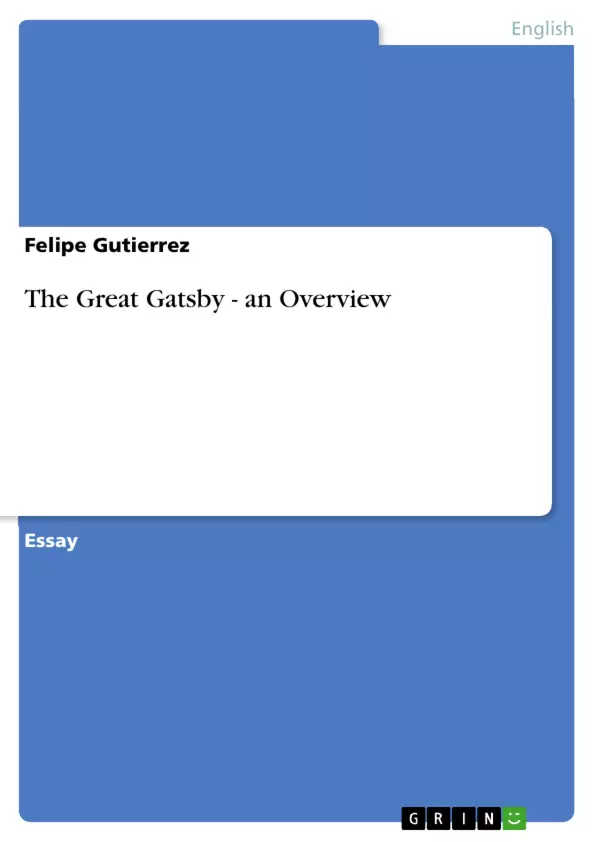As The Great Gatsby by F. Scott Fitzgerald begins Nick Carraway is introduced as the protagonist of the novel. There are various major characters in this novel; nevertheless the protagonist, Nick, helps shape the novel’s plot through his personality and way of living. Nick comes from a well-known family that has lived in the Middle Western city for three extensive generations. The founder of this illustrious family was Nick’s grandfather’s brother, who started a wholesale hardware business, which Nick’s father carries on in the novel. Moreover, Nick graduated from Haven in 1915, twenty-five years after his father. He then participated in the Teutonic migration known as the Great War; Nick was part of the Third Division and was in the ninth machine-gun battalion. Nick then decided to move to the East in 1922 due to the gossip and rumors that circled his personal life. For instance, there were various rumors that Nick was engaged, which are clearly false. The reader can then see that Nick is a man that is easily influenced and bothered by other people’s ideas/statements. Nonetheless Nick wanted to learn the bond business because the Middle West had began to seem as if it were the “ragged edge of the universe.” Nick traveled east of New York, where he began to live at West Egg, which is less stylish, when compared to East Egg. Nick’s house was at the top of the egg, giving him a great view of the neighboring houses. Additionally, Nick bought several volumes on banking and credit, revealing to the reader that Nick is a man that wants to be someone in the world, obtaining a high-quality job in his profession and becoming wealthy.
Table of Contents
- Introduction
- Nick Carraway
- Jay Gatsby
- Daisy Buchanan
- Tom Buchanan
- Myrtle Wilson
- George B. Wilson
- Jordan Baker
- The Climax
- Conclusion
Objectives and Key Themes
The novel "The Great Gatsby" by F. Scott Fitzgerald explores the themes of love, wealth, and the American Dream through the lens of a complex cast of characters. Through the eyes of the protagonist, Nick Carraway, the reader is invited into a world of opulent parties, hidden affairs, and the pursuit of elusive dreams. The story delves into the consequences of social climbing, unfulfilled desires, and the deceptive nature of appearances.
- The destructive nature of love and obsession
- The allure and corruption of wealth
- The unattainable nature of the American Dream
- The complexities of social class and status
- The destructive consequences of deceit and betrayal
Chapter Summaries
The novel opens with Nick Carraway's arrival in West Egg, Long Island, where he becomes acquainted with the enigmatic Jay Gatsby. Gatsby's extravagant parties and mysterious past intrigue Nick, leading him to delve into the intricacies of Gatsby's relationship with Daisy Buchanan, Tom Buchanan's wife. The narrative unravels the tangled web of love and deceit, showcasing the passionate yet ultimately destructive nature of Gatsby's obsession with Daisy.
As the story unfolds, Nick witnesses the escalating tensions between Gatsby and Tom, fueled by Tom's possessive nature and Daisy's torn loyalties. The tragic climax of the novel occurs when Gatsby takes the blame for an accident involving Myrtle Wilson, Tom's mistress, leading to a devastating confrontation that irrevocably alters the lives of all involved.
Through Nick's observant perspective, the novel offers a poignant commentary on the disillusionment of the American Dream, the fragility of human relationships, and the enduring power of past regrets.
Keywords
The novel explores the themes of love, wealth, and the American Dream through the lens of characters such as Jay Gatsby, Daisy Buchanan, and Tom Buchanan. Key concepts include social climbing, unfulfilled desires, the deceptive nature of appearances, and the destructive consequences of obsession and betrayal.
- Quote paper
- Felipe Gutierrez (Author), 2011, The Great Gatsby - an Overview, Munich, GRIN Verlag, https://www.grin.com/document/167751



